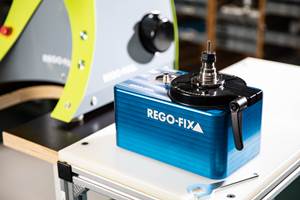Get The Feed Rate Right When Thread Milling
Does your machine control specify radial feed rate from the edge of a tool or its center? Not knowing can cause much longer cycle times or greatly reduced tool life during thread milling operations.
Share







Takumi USA
Featured Content
View More

Autodesk, Inc.
Featured Content
View More
ECi Software Solutions, Inc.
Featured Content
View MoreShops that adopt new machining practices face learning curves of varying slopes. Basic inexperience with new approaches means some process-optimizing details can be overlooked, too.
Consider thread milling. An alternative to tapping, thread milling makes it possible to use a single tool to thread a variety of diameters that share a common pitch. In addition, it has the ability to machine threads very close to the bottom of a blind hole. Thread milling also generates short, controllable chips (instead of long, stringy ones) that are readily evacuated out of both blind and through holes. Specifying the correct radial feed rate in the machining program is the key to achieving short cycle times and long tool life during thread milling operations. It’s possible, though, that shops new to thread milling don’t know if they’re using the right rate.
This is because some machine controls specify feed rate at the center of a tool, while others use the feed rate at a tool’s outer edge. (In a circular movement, the feed at the center of the tool is slower than the feed at the cutting edge.) Inexperienced operators might not know whether the “F” command, which defines the radial tool feed rate in a thread milling program, refers to the feed at the tool’s center or its edge.
Vargus USA, a manufacturer of Vardex thread milling tools, highlights the significance of using the correct feed rate with this example. For a 4.8-mm thread mill used to create an M6 x 1 thread, the feed rate at the edge of the tool is 238 mm/min. Conversely, the feed rate at the center of that tool is only 47 mm/min. Moving the tool too slowly leads to extended machining time (five times longer in this example). On the other hand, a tool that moves too fast can experience high cutting loads that significantly reduce tool life.
Vargus USA offers free software that can ensure operators use the correct radial feed rate during thread milling operations. The company’s TM Gen is a PC-based program that guides users through a few simple steps to define the thread milling application. It then provides all the information needed to run the threading job. This includes the feed rates for both the tool center and edge as well as calculated cycle times for both feed scenarios. If the actual machining time is drastically different than what the software calculates, then the machine control is moving the thread mill at the wrong feed rate. Operators can then change the feed to the correct value as provided by the software.
The TM Gen software creates G-code for many popular controls, including Fanuc, Heidenhain, Mazatrol, Mitsubishi and Siemens. It is available for free download at the company’s Web site (vardex.com). Vargus USA also offers a similar software program called TT Gen for thread turning applications. The TT Gen software provides a comprehensive, printable report that recommends proper insert and toolholder, carbide insert grade, and feeds and speeds. The latest version of this software supports 10 languages as well as both inch and metric measurement units.
Related Content
Selecting a Thread Mill That Matches Your Needs
Threading tools with the flexibility to thread a broad variety of holes provide the agility many shops need to stay competitive. They may be the only solution for many difficult materials.
Read MoreThe Future of High Feed Milling in Modern Manufacturing
Achieve higher metal removal rates and enhanced predictability with ISCAR’s advanced high-feed milling tools — optimized for today’s competitive global market.
Read MoreToolpath Improves Chip Management for Swiss-Type Lathes
This simple change to a Swiss-type turning machine’s toolpath can dramatically improve its ability to manage chips.
Read MoreFive Common Mistakes Shops Make with ER Collets (And How to Prevent Them)
Collets play a crucial role in the machining process, so proper tool assembly and maintenance is important. Here are five potential pitfalls to avoid when using ER collets.
Read MoreRead Next
5 Rules of Thumb for Buying CNC Machine Tools
Use these tips to carefully plan your machine tool purchases and to avoid regretting your decision later.
Read MoreRegistration Now Open for the Precision Machining Technology Show (PMTS) 2025
The precision machining industry’s premier event returns to Cleveland, OH, April 1-3.
Read MoreBuilding Out a Foundation for Student Machinists
Autodesk and Haas have teamed up to produce an introductory course for students that covers the basics of CAD, CAM and CNC while providing them with a portfolio part.
Read More




















.png;maxWidth=150)












.png;maxWidth=300;quality=90)









